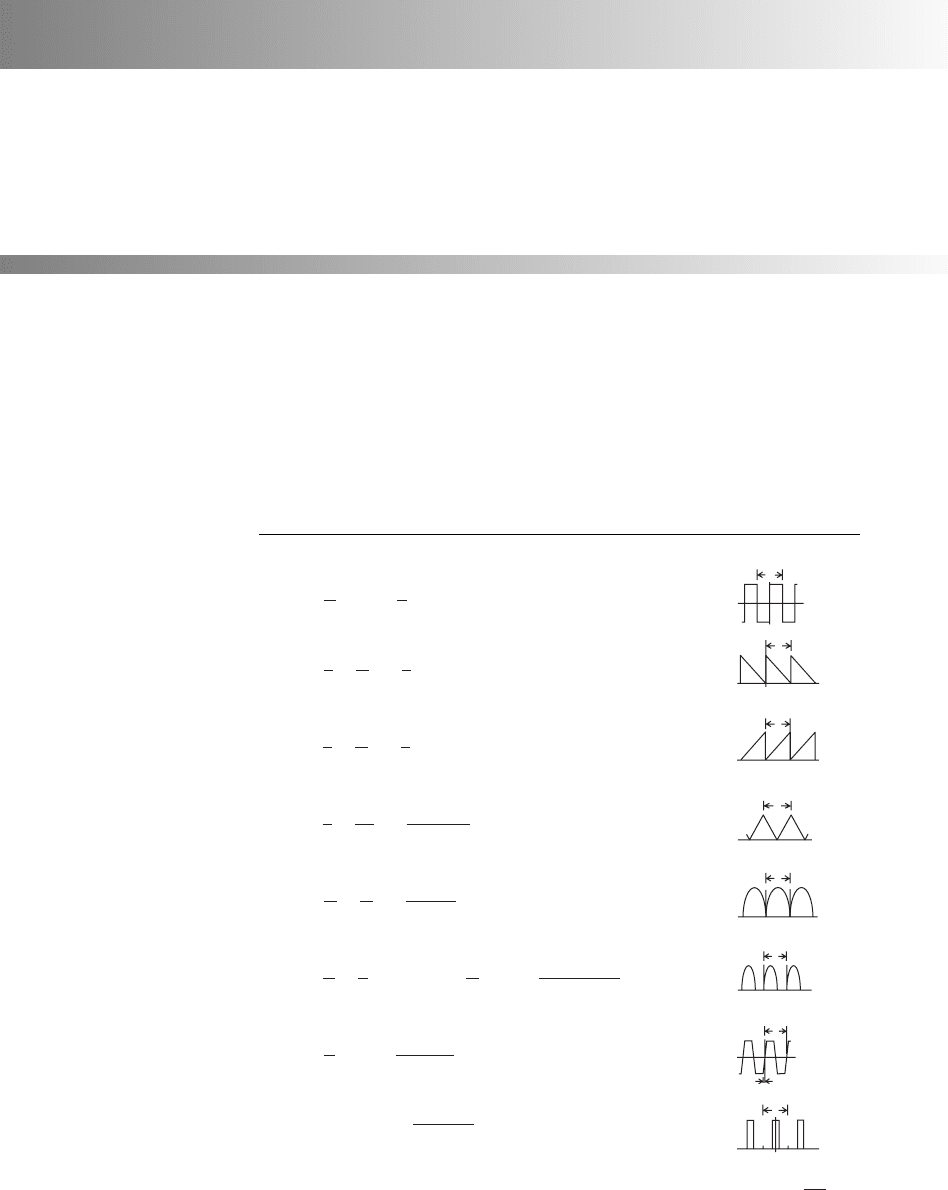Balakumar Balachandran, Magrab E.B. Vibrations
Подождите немного. Документ загружается.


660
APPENDIX B
Fourier Series
TABLE B
Fourier Series
1
Fourier Series Waveform
a) Square wave
b) Sawtooth
c) Sawtooth
d) Triangular wave
e) Rectified sine wave
f) Half sine wave
g) Trapezoidal
h) Pulse train (a t
d
/T)
1
In the notation of Section 5.9, 2ipt/T i
o
t, T 2p/v
o
,
o
v
o
/v
n
, t v
n
t, and v
n
]. The
amplitudes of all waveforms vary from either 0 to 1 or 1 to 1.
2k/m
f 1t 2 a c1 2
a
i1
sin 1ipa 2
1ipa2
cos 12ipt/T2d
f 1t2
4
a
a
i1,3,5 p
sin1ipa 2
1pi 2
2
sin 12ipt/T 2
f 1t 2
1
p
1
2
sin12pt/T2
2
p
a
i2,4,6, p
cos 12ipt/T 2
i
2
1
f
1t 2
2
p
4
p
a
i1
1
1 4i
2
cos 12ipt/T2
f 1t 2
1
2
4
p
2
a
i1
1
12i 1 2
2
cos 112i 12pt/T2
f 1t 2
1
2
1
p
a
i1
1
i
sin 12ipt/T 2
f 1t2
1
2
1
p
a
i1
1
i
sin 12ipt/T 2
f 1t2
4
p
a
i1,3,5 p
1
i
sin 12ipt/T 2
T
t
T
t
T
t
T
t
T
t
T
t
T
t
α
T/2
t
T

661661
APPENDIX C
Decibel Scale
The decibel is a unit of measurement for vibrations (and other phenomena),
and is it defined
1
as
(C.1)
or
(C.2)
where P is a power or a power-like quantity, P
ref
is a reference quantity hav-
ing the same engineering units as P, A is an amplitude-like quantity and A
ref
is a reference quantity having the same engineering units as A. Examples of
P are electrical power in watts, system energy, acoustic intensity in watts/m
2
;
examples of A are voltage, displacement, velocity, and acceleration. The des-
ignation dB does not pertain to a particular physical quantity and therefore, it
is not a physical unit in the ordinary sense. It simply indicates the relative
magnitudes of two like quantities as shown in Eqs. (C.1) and (C.2).
The main reason for the introduction and use of the decibel is to com-
press logarithmically very large and very small numbers into a more man-
ageable scale and to provide a convenient manner in which to talk about them.
From Eq. (C.2), we see that for amplitude-like quantities each factor of 10 in-
crease with respect to the reference quantity corresponds to 20 dB, whereas a
decrease by a factor of 10 corresponds to 20 dB. Thus, 60 dB means that an
amplitude-like quantity is 1000 times larger than the reference quantity and
60 dB indicates that it is 1000 times smaller. Two ratios that are of special
interest are A/A
ref
and A/A
ref
1/ , which correspond to 3 dB and
3 dB, respectively. For power-like quantities, P/P
ref
2 and P/P
ref
1/2
also correspond to 3 dB and 3 dB, respectively.
12
12
L
A
20 log
10
A
A
ref
dB
L
P
10 log
10
P
P
ref
dB
1
“Acoustics—Expressions of Physical and Subjective Magnitudes of Sound or Noise in the Air,”
ISO 131, International Standards Organization, Geneva, Switzerland (1979).

EXPRESSING ERRORS IN DB
Frequently, errors are expressed in dB. Consider the usual definition of the
percentage error # of an amplitude-like quantity A with respect to a reference
quantity A
ref
:
(C.3)
or
(C.4)
If the ratio A/A
ref
is expressed as dB, then from Eq. (C.2)
(C.5)
or
(C.6)
Therefore, from Eqs. (C.3) through (C.6), we obtain,
(C.7)
or
(C.8)
Typical equivalent values for # and are given in Table C. Note that
dB does not, in general, correspond to # %, although for 1 dB, they
are fairly close.
¢ 20 log
10
a1
P
100
b
P 100110
¢/20
12
A
A
ref
10
¢/20
¢ 20 log
10
A
A
ref
dB
A
A
ref
1
P
100
P 100
A A
ref
A
ref
100 a
A
A
ref
1b%
662 APPENDIX C Decibel Scale
TABLE C
Relationship Between an Error
Expressed in dB to One Expressed as
a Percentage
(dB) #(%)
0.01 0.12
0.01 0.12
0.10 1.16
0.10 1.14
0.50 5.93
0.50 5.59
1.00 12.20
1.00 10.87
1.50 18.85
1.50 15.86
2.00 25.89
2.00 20.57
3.00 41.25
3.00 29.21

663
APPENDIX D
Solutions to Ordinary Differential Equations
There are many methods available for obtaining the solution to linear inho-
mogeneous ordinary differential equations. We shall present summaries of the
following methods that can be used to obtain a general solution to an ordinary
differential equation with constant coefficients and with prescribed initial
conditions: (1) Laplace transforms; (2) variation of parameters; and (3) state-
space method (reduction of order). The latter two methods can also be used to
obtain solutions when the coefficients are a function of the independent vari-
able. We also summarize several methods that can be used to obtain the solu-
tion to a second-order equation where the independent variable is time and the
inhomogeneous term varies harmonically with respect to this independent
variable.
GENERAL SOLUTION METHODS
Laplace Transforms
1
Consider Eq. (3.22), which is
(D.1)
where v
n
is given by Eq. (3.14) [or Eq. (3.16)] and z is given by Eq. (3.18) [or
Eq. (3.21)]. The Laplace transform of Eq. (D.1) is obtained by using the
Laplace transform pair 2 in Table A of Appendix A. This leads to
Laplace transform of
(t)
Laplace transform of
(t)
Laplace Laplace
transform transform
of
x(t)
of
f(t)
x
#
x
$
s
2
X 1s2 x
#
10 2 sx102 2zv
n
3sX 1s 2 x1024 v
n
2
X 1s2
1
m
F1s 2
d
2
x
dt
2
2zv
n
dx
dt
v
2
n
x
f 1t 2
m
⎫
⎬
⎭
⎫
⎬
⎭
⎫
⎪
⎪
⎬
⎪
⎪
⎭
⎫
⎪
⎪
⎪
⎪
⎬
⎪
⎪
⎪
⎪
⎭
1
See Appendix A.

which, upon rearrangement, becomes
(D.2)
In Eq. (D.2), x(0) is the value of x at t 0, is the value of first derivative
of x at t 0, F(s) indicates the Laplace transform of f(t), and
(D.3)
On writing D(s) as
we have
(D.4)
We now rewrite Eq. (D.2) as
(D.5)
where
(D.6)
Upon using pairs 27 and 28 of Table A in Appendix A, the inverse Laplace
transform of Eqs. (D.6) is
(D.7)
The inverse transform of the product F(s)G
2
(s) is obtained from pair 4 of
Table A in Appendix A as
(D.8)
Then, using Eqs. (D.7) and (D.8) in Eq. (D.5), the inverse Laplace transform
of Eq. (D.5) is given by
t
0
g
2
1h 2f 1t h 2dh
g
2
1t 2
e
zv
n
t
v¿
d
sinh v¿
d
t
g
1
1t 2
e
zv
n
t
v¿
d
3zv
n
sinh v¿
d
t v¿
d
cosh v¿
d
t4
G
2
1s 2
1
1s s
1
21s s
2
2
G
1
1s 2
s
1s s
1
21s s
2
2
X 1s 2 x10 23G
1
1s 2 2zv
n
G
2
1s 24 x
#
10 2G
2
1s 2
1
m
F
1s 2G
2
1s 2
v¿
d
v
n
2z
2
1
s
1,2
zv
n
v¿
d
D1s 2 1s s
1
21s s
2
2
D1s 2 s
2
2zv
n
s v
2
n
x
#
10 2
X 1s2
sx10 2
D1s 2
2zv
n
x10 2 x
#
10 2
D1s 2
F1s 2
mD1s 2
664 APPENDIX D Solutions to Ordinary Differential Equations

(D.9)
and we have introduced the definitions x(0) X
o
and .
Based on the magnitude of z, Eq. (D.9) has four different forms that are
given below.
0 1 In this range, we rewrite Eq. (D.4) as
where
(D.10)
After substituting Eq. (D.10) into Eq. (D.9) and using the last of Eqs. (F.22)
from Appendix F, we arrive at
(D.11a)
or
(D.11b)
and we have used the property that
This integral is called the convolution integral.
By using the identity
(D.12)c
tan
1
b
a
a
sin 1vt 2 bcos 1vt2 2a
2
b
2
sin 1vt c 2
t
0
h1t h 2f 1h2dh
t
0
h1h 2f 1t h2dh
1
mv
d
t
0
e
zv
n
1th2
sin 1v
d
1t h22f 1h2dh
x1t 2 X
o
e
zv
n
t
cos 1v
d
t2
V
o
zv
n
X
o
v
d
e
zv
n
t
sin 1v
d
t2
1
mv
d
t
0
e
zv
n
h
sin 1v
d
h2f 1t h 2dh
x1t 2 X
o
e
zv
n
t
cos 1v
d
t2
V
o
zv
n
X
o
v
d
e
zv
n
t
sin 1v
d
t2
v
d
v
n
21 z
2
v¿
d
jv
d
x
#
10 2 V
o
1
mv¿
d
t
0
e
zv
n
h
sinh 1v¿
d
h2f 1t h2dh
x1t 2 X
o
e
zv
n
t
v¿
d
3zv
n
sinh v¿
d
t v¿
d
cosh v¿
d
t4 V
o
e
zv
n
t
v¿
d
sinh v¿
d
t
General Solution Methods 665

we can also write Eq. (D.11a) in the form
(D.13)
where A
o
and w
d
are given by
(D.14)
There are two special cases of Eqs. (D.11) and (D.13) that are of interest.
Case 1: X
o
0, V
o
0, and f(t) 0
For this case, Eqs. (D.11) and (D.13) simplify to
(D.15)
and
(D.16)
respectively.
Case 2: X
o
0, V
o
0, and f(t ) 0
For this case, Eqs. (D.11a) and (D.13) both simplify to
(D.17)
z
1 The solution for this value of z can be obtained by taking the limit
z 씮 1 in Eq. (D.11a). Thus, noting that
we arrive at
(D.18)
There are two special cases of Eqs. (D.18) that are of interest.
x1t 2 X
o
e
v
n
t
3V
o
v
n
X
o
4te
v
n
t
1
m
t
0
he
v
n
h
f 1t h 2dh
lim
z씮 1
cos v
d
t lim
z씮 1
cos v
n
t21 z
2
1
lim
z씮 1
sinv
d
t
v
d
t lim
z씮 1
sin v
n
t21 z
2
v
n
t21 z
2
t
x1t 2
1
mv
d
t
0
e
zv
n
h
sin 1v
d
h2f 1t h 2dh
x1t 2 A
o
e
zv
n
t
sin 1v
d
t w
d
2
x1t 2 X
o
e
zv
n
t
cos 1v
d
t2
V
o
zv
n
X
o
v
d
e
zv
n
t
sin 1v
d
t2
w
d
tan
1
v
d
X
o
V
o
zv
n
X
o
A
o
B
X
2
o
a
V
o
zv
n
X
o
v
d
b
2
x1t 2 A
o
e
zv
n
t
sin 1v
d
t w
d
2
1
mv
d
t
0
e
zv
n
h
sin 1v
d
h2f 1t h 2dh
666 APPENDIX D Solutions to Ordinary Differential Equations

Case 1: X
o
0, V
o
0, and f(t) 0
For this case, Eq. (D.18) simplifies to
(D.19)
Case 2: X
o
0, V
o
0, and f(t) 0
For this case, Eq. (D.18) simplifies to
(D.20)
z
1 In this case, we use Eq. (D.9) directly.
z
0 In this case, the solution can be obtained by taking the limit as z 씮 0
in Eqs. (D.11) and (D.13). Thus, noting from Eqs. (D.10) that,
we find that Eq. (D.11a) becomes
(D.21)
and Eq. (D.13) becomes
(D.22)
respectively, where the and are, respectively, given by
(D.23)
There are two special cases of Eqs. (D.21) and (D.22) that are of interest.
Case 1: X
o
0, V
o
0, and f(t) 0
For this case, Eqs. (D.21) and (D.22) simplify to
(D.24)
and
(D.25)
respectively.
x1t 2 A¿
o
sin 1v
n
t w¿
d
2
x1t 2 X
o
cos 1v
n
t2
V
o
v
n
sin 1v
n
t2
w¿
d
tan
1
v
n
X
o
V
o
A¿
o
B
X
2
o
a
V
o
v
n
b
2
w¿
d
A¿
o
x1t 2 A¿
o
sin1v
n
t w¿
d
2
1
mv
n
t
0
sin1v
n
h2f 1t h 2dh
x1t 2 X
o
cos1v
n
t2
V
o
v
n
sin1v
n
t2
1
mv
n
t
0
sin1v
n
h2f 1t h 2dh
lim
z씮 0
v
d
v
n
x1t 2
1
m
t
0
he
v
n
h
f 1t h 2dh
x1t 2 X
o
e
v
n
t
3V
o
v
n
X
o
4te
v
n
t
General Solution Methods 667

Case 2: X
o
0, V
o
0, and f(t) 0
For this case, Eqs. (D.21) and (D.22) both simplify to
(D.26)
Variation of Parameters
Again consider the second-order equation given by Eq. (D.1). Let the two lin-
early independent solutions to this equation when f(t) 0, called the homo-
geneous equation, be denoted u
1
(t) and u
2
(t). Then the solution
2
that satisfies
Eq. (D.1) is
(D.27)
where W(u
1
(j),u
2
(j)), called the Wronskian, is given by
(D.28)
and j is the variable of integration.
The homogeneous form of Eq. (D.1) is
(D.29)
A solution to Eq. (D.29) is obtained by assuming a solution of the form
(D.30)
Upon substituting Eq. (D.30) into Eq. (D.29), we obtain
(D.31)
which has the two roots
(D.32)
where v
d
is given by Eq. (D.10) and we have assumed that 0 z 1. Then,
the two linearly independent solutions are
(D.33)u
2
1t 2 e
1zv
n
jv
d
2t
u
1
1t 2 e
1zv
n
jv
d
2t
l
1,2
zv
n
jv
d
l
2
2zv
n
l v
2
n
0
x1t 2 e
lt
d
2
x
dt
2
2zv
n
dx
dt
v
2
n
x 0
W1u
1
1j 2,u
2
1j 22 det 3
u
1
1j 2 u
2
1j 2
du
1
1j 2
dj
du
2
1j 2
dj
3 u
1
1j 2
du
2
1j 2
dj
u
2
1j 2
du
1
1j 2
dj
x1t 2 C
1
u
1
1t 2 C
2
u
2
1t 2
1
m
t
2
t
1
f 1j23u
1
1j 2u
2
1t 2 u
2
1j 2u
1
1t 24
W1u
1
1j 2, u
2
1j 22
dj
x1t 2
1
mv
n
t
0
sin 1v
n
h2f 1t h 2dh
668 APPENDIX D Solutions to Ordinary Differential Equations
2
See for example, F. B. Hildebrand, Advanced Calculus for Applications, Prentice Hall, Saddle
River, NY, p. 26, 1976.

To obtain the solution to the inhomogeneous equation for arbitrary f(t),
we use Eq. (D.33) in Eq. (D.27). First, we note that Eq. (D.28) becomes
(D.34)
and that
(D.35)
Upon substituting Eqs. (D.33), (D.34), and (D.35) into Eq. (D.27), we obtain
(D.36)
It is customary to rearrange the homogeneous portion of the solution by defin-
ing two new arbitrary constants as follows:
(D.37)
Then, the final form of the solution is
(D.38)
If we use Eq. (D.38) to solve the case where x(0) X
o
and ,
then we find that
(D.39)
and the solution is identical to that given by Eq. (D.11b).
State-Space Form
Many numerical procedures used to solve ordinary differential equations re-
quire that the equations be written as a system of first-order differential
A
2
V
o
zv
n
X
o
v
d
A
1
X
o
x
#
10 2 V
o
x1t 2 A
1
e
zv
n
t
cos v
d
t A
2
e
zv
n
t
sin v
d
t
1
mv
d
t
2
t
1
e
zv
n
1jt2
sin3v
d
1t j24f 1j 2dj
A
1
e
zv
n
t
cos v
d
t A
2
e
zv
n
t
sin v
d
t
e
zv
n
t
11C
1
C
2
2cos v
d
t j1C
1
C
2
2sin v
d
t2
C
1
e
1zv
n
jv
d
2t
C
2
e
1zv
n
jv
d
2t
e
zv
n
t
1C
1
e
jv
d
t
C
2
e
jv
d
t
2
C
1
e
1zv
n
jv
d
2t
C
2
e
1zv
n
jv
d
2t
1
mv
d
t
2
t
1
e
zv
n
1jt2
sin3v
d
1t j24f 1j 2dj
x1t 2 C
1
e
1zv
n
jv
d
2t
C
2
e
1zv
n
jv
d
2t
1
m
t
2
t
1
2 je
zv
n
1jt2
sin3v
d
1j t24f 1j2
2 jv
d
e
2zv
n
j
dj
2 je
zv
n
1jt2
sin 3v
d
1j t24
e
zv
n
1jt2
1e
jv
d
1jt2
e
jv
d
1jt2
2
e
zv
n
1jt2jv
d
1jt2
e
zv
n
1jt2jv
d
1jt2
u
1
1j 2u
2
1t 2 u
2
1j 2u
1
1t 2 e
1zv
n
jv
d
2j
e
1zv
n
jv
d
2t
e
1zv
n
jv
d
2j
e
1zv
n
jv
d
2t
2 jv
d
e
2zv
n
j
1zv
n
jv
d
2e
1zv
n
jv
d
2j
e
1zv
n
jv
d
2j
W1u
1
1j 2, u
2
1j 22 1zv
n
jv
d
2e
1zv
n
jv
d
2j
e
1zv
n
jv
d
2j
General Solution Methods 669
